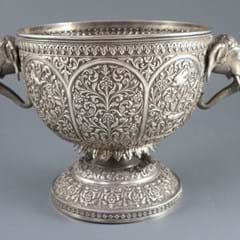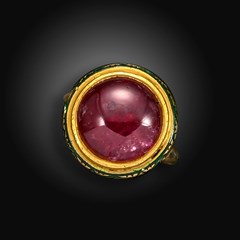How to start your Islamic Art collection
Often distinctive and vibrant, the visual arts produced in the Islamic world cover a wide range of genres, periods and lands.An Iznik pottery dish from the first half of the 17th century. Of typical shallow shape with floral design, it sold for £800 at Chiswick Auctions in October 2019.
Unlike Christian art, these items comprise both religious and secular art forms with one of the key ideas being that, because Islam is integral to a Muslim's life and makes it beautiful, everyday items should also be made beautiful by Islamic art.
Buying and collecting Islamic art helps you to access and appreciate centuries of culture and knowledge as well as enabling you to enjoy beautifully crafted objects. Good entry-level items for collectors can be picked up at auction for low three-figure prices.
Rarer, higher-quality pieces will run into thousands of pounds.
Types of Islamic art
The categories of Islamic art that regularly comes up for sale include:
- Glass – for most of the Middle Ages, Islamic glass was exported to both Europe and China due to its high levels of sophistication.
- Metalwork – practical objects mostly in bronze, brass and steel, characterised by simple shapes and highly decorated surfaces.
- Ceramics – Islamic ceramics, both pottery and wall tiles, are particularly noteworthy for the levels of craftsmanship attained. Look out the Iznik red colour in Islamic pottery.
- Rugs, carpets and textiles – outside the Islamic world these are arguably the best-known products from the region. Used in everyday Islamic life, they range from floor coverings and cushions to bags and prayer rugs.
- Calligraphy – decorative handwriting pervades Islamic art, whether on coins or buildings or adorning pots or appearing in manuscripts. Calligraphers enjoyed a high status in Islamic society.
- Painting – the miniature artworks in illuminated manuscripts are often regarded as one of the most developed forms of painting in Islamic art.
Empires that influenced art
Much of the great art within the Islamic world was produced under the patronage of a ruling court. Today, the names of different empires may appear in lot descriptions at auction such as:
- Ottoman Empire – Constantinople (modern day Istanbul) was its capital which put it at the centre of interactions between the Eastern and Western worlds for six centuries from the 14th century onwards.
- Mughal Empire – covering much of South Asia from the 16th century until the 19th century
- Safavid dynasty – ruling over Iran from the 16th century to the 18th century
- Qajar dynasty – ruling over Iran from the end of the 18th century to 1925
Where and when to buy
Look for specialist auctions that occur periodically throughout the year, with a peak in May and November. These sales will have been put together by an expert at the auction house who will be available to answer your questions.
Such auctions are often called ‘Islamic and Indian Art’ or ‘Asian and Islamic Art’.
What to do next
Decide how much you’d like to spend and use the search facility on thesaleroom.com to find Islamic art coming up for sale. You can filter your search by, among other things, price and by location of the auction house to narrow down your selection.
To research recent prices at auction so you can see how much each type of object sold for you can also try out the Price Guide.
If you are new to bidding check out our guides to buying at auction – it’s easy once you know how.













